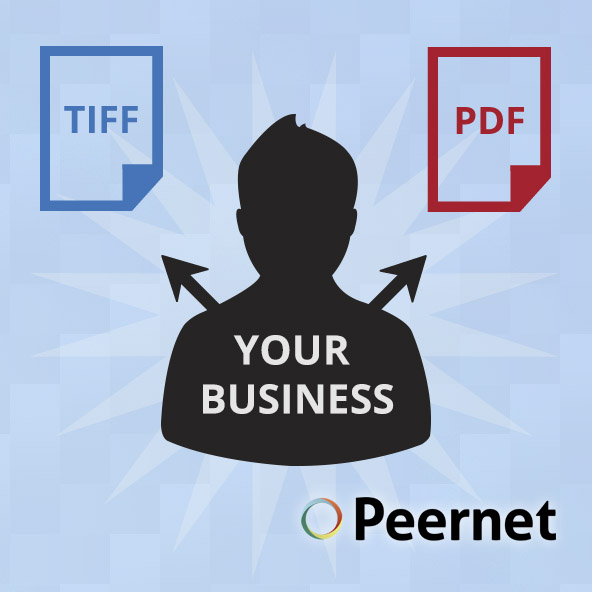PDF or TIFF – Which One is Better for Your Company?

Whether you work on your own, or as part of a medium or even very large, enterprise company, you probably have an ongoing need to maintain digital document records. For that purpose, two of the best formats are PDF (portable document format) and TIFF (tagged image file format). Both are widely-used throughout the business world, and both have their advantages and drawbacks.
In this post, we’ll compare the two file formats to examine which might be the best fit for your needs. Later on, we’ll suggest a few file conversion software solutions that make creating PDFs or creating TIFFs easy, and that can scale nicely to your requirements.
Advantages of Each File Type
File Quality: Both formats are capable of producing high-quality replications of original documents. TIFF was originally designed as a standard format for scanned documents, and it is a lossless format – meaning data in the original file is not lost when it is saved as a TIFF. This ensures a high quality output each time. TIFF does have some compression options available but generally, the outputted file will remain very high quality.
PDF, on the other hand, can run a wider range of document quality, depending on the user’s requirements. It is capable of maintaining extremely high quality (particularly the vector PDF formats), indistinguishable to the human eye. Conversely, the user can also adjust settings to create a much lower-quality PDF document, if there is a need to keep file sizes smaller. Overall, the advantage would go to TIFF, but PDF gives you the added flexibility to easily adjust quality as needed.
File Size: Generally speaking, the higher the quality of a file, the more storage space it will take up. In this category, PDF has the advantage. For all their benefits, outputted TIFF image files are often quite large in size. For smaller organizations or personal users with limited resources this could be somewhat problematic in the long run. If you or your organization has either (a) limited digital document storage space and resources or (b) a massive amount of digital documentation, then PDF could be the right format for you. A lower file size has not only the advantage of a reduced need for storage capacity, but also makes the files easier and more practical to share among clients and colleagues.
Document Security: If maintaining the security of your documents, and potentially the privacy of your customer/clients’ sensitive data, is a priority, then the best course of action is establishing a comprehensive IT security protocol. That includes processes, procedures, and software to keep your documents safe. But beyond that main line of defense, both PDF and TIFF offer some good security features that can provide an added layer of protection.
First, we’ll look at TIFF. The files cannot be embedded with links or other data such as malware, and malicious links are a big tool that hackers use in their arsenal of tricks. The high-quality output of the files also makes TIFF files difficult to edit convincingly, which is another mark in their favour.
PDF files, on the other hand, can be protected via password to prevent prying eyes from reading your documents without the password. Some software also allows the creator to specify certain permissions.
Depending on the specific use of these files and documents within your organization, you may find that either set of security features is more beneficial.
Multimedia Elements: TIFF is a pure image format, and as mentioned, elements like clickable hyperlinks cannot be embedded within the file. While this is a plus from the document security standpoint, it means that TIFF is not particularly well-suited as a multimedia format. PDF, on the other hand, allows you to make extensive use of crawlable text, clickable links and other elements. That makes it a good fit if you want to provide a document that prints out identically each time, but contains additional functionality when viewed on a computer. One thing to keep in mind, however, is that you’ll need to ensure that the image quality is high enough within the PDFs to be printed clearly on a physical piece of paper. With TIFF, you can generally rest easy that the quality is more than high enough to be printed clearly. For this reason (its high-resolution output), TIFF is generally preferred as the image format of choice for the publishing profession.
Searchability: Both formats have their plusses and minuses, and if you have a regular need to search and retrieve documents once they are converted, this is something to keep in mind. The first thing to know is that when we speak of PDFs, we’re actually talking about two different, main types of portable document format files. The first is a raster file, in which all information on page is rendered as an image. This means that any text on the page is not actually read by the computer as text, rather, a graphical image (i.e. you can’t drag your cursor over individual passages, can’t copy and paste the specific text, etc.) TIFF, being a pure image format, renders text in the same manner, so you would need to perform an optical character recognition (OCR) process on the file to convert that image into crawlable, searchable text. On the other hand, there are vector PDFs. In vector PDFs, text is rendered as clickable and crawlable. So if you are looking for a specific piece of information within a vector PDF file, you can just do a ‘Find’ command (ctrl + f in Windows), enter your search query, and it should find that exact text.
In terms of finding those documents in the first place, PDF files allow meta data to be embedded directly within the file, which can help make file sorting and retrieval an easier process. Large-scale organizations making use of TIFF for document storage and retrieval will generally have some sort of database to index the information contained in each TIFF file.
Cross-platform support: A big part of the success of both file formats is their widespread support and usage. Both formats are widely-used and supported on all major devices and operating systems – Windows, Mac, Linux and mobile platforms. This makes both formats a great choice if your employees are working remotely, or if you’re sharing files with a customer or client.
Annotation and document markup: If your company makes use of documents that require notes, annotations, highlights and the like, then PDF is the best option (you can utilize software like PEERNET’s PDF Creator Plus for these sorts of features.)
How to Convert to PDF or TIFF?
Now that you understand the benefits, drawbacks, similarities and differences between these two popular file formats, we’ll take a brief look at the best way to create these files within your own organization.
Image Printers
PEERNET’s line of image printers makes creating TIFF files and creating JPEG files very easy. These solutions include TIFF Image Printer, PDF Image Printer, and Raster Image Printer (which combines the functionality of the first two into one package.)
Once installed, the image printers basically function as virtual printers, a.k.a. print drivers. So when a user goes to print a document in the usual manner, there is the option to simply “print to PDF” or “print to TIFF”.
This makes it an extremely useful solution to address your need for an easy, on-demand TIFF or PDF creation tool within your company. These image printers seamlessly integrate into your existing operating systems in place within your organization. That integration can save you significant time and resources within your company: there is little training involved, because if a user is capable of printing an ordinary document, they are now capable of easily converting files. The other way that image printers save your company resources is that they are capable of handling any Windows file that you can open and print into TIFF or PDF. So a solution such as Raster Image Printer can save you the trouble of employing multiple different pieces of software.
Ongoing, automated file conversion
Some organizations have a need for ongoing file conversion. This sort of automated conversion requirement is often seen within enterprise-level organizations, and institutions within fields like the medical profession, legal firms or financial services. For this level of requirements, the best solution is to batch convert documents on an ongoing basis; this is what PEERNET’s Document Conversion Service (DCS) is designed for.
DCS is purpose-built from the ground up to save organizations huge amounts of time and resources; rather than converting files to the required format as-needed, the work is done automatically, in the background on an ongoing basis. Document Conversion Service boasts a rich and robust set of features for advanced users to customize the outputted, converted TIFF files or PDF files. Large and prestigious organizations around the world entrust DCS for their PDF and TIFF creation needs.
Start Utilizing PDF or TIFF today
In the end, there is no overall superior file format between PDF or TIFF; both are extremely useful for corporate digital documentation systems. The best format to utilize in your company will very much depend on your particular needs. If you need some more information to decide which format is best for your organization, please contact us and we’ll be happy to point you in the right direction.
Additionally, if you’re unclear about which professional file conversion software solution fits your requirements most closely, please watch the short 2 minute video below.



